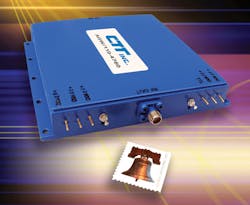GaN-Based PAs Power 7 To 11 GHz
This file type includes high resolution graphics and schematics when applicable.
Amplification at output levels as high as 100 W at X-band frequencies has traditionally required the use of vacuum tubes, such as traveling-wave-tube amplifiers (TWTAs). But the latest pair of solid-state power amplifiers (SSPAs) from CTT, Inc. is based on gallium-nitride (GaN) solid-state devices. These SSPAs are capable of replacing TWTAs in many X-band applications, with as much as 50 W continuous-wave (CW) output power across broad bandwidths at X-band frequencies, and as much as 100 W pulsed output power across 1-GHz bandwidths at X-band frequencies.
The GaN amplifiers meet many signal-strengthening requirements for applications in the well-occupied 7-to-11-GHz portion of the electromagnetic (EM) spectrum, providing high gain and significant output-power levels with high efficiency and reasonable current/power consumption. Some of these applications include point-to-point links for high-data-rate communications; satellite-communications (satcom) uplinks from 7.9 to 8.4 GHz for military satellite communications (MILSATCOM), per standards established by such organizations as the International Telecommunications Union (ITU) and the European Telecommunications Satellite Institute (ETSI); and for CW and pulsed applications in civil, government, and military systems for weather monitoring, air traffic control, surveillance, and missile tracking [including for electronically scanned arrays (ESAs) and active ESA (AESA) systems]. These broadband amplifiers are also good fits for test systems requiring signals at higher power levels, including for simulators and electromagnetic-interference (EMI) test systems.
The broadband GaN SSPAs feature a common mechanical platform with an open architecture, affording a great deal of flexibility in terms of meeting customers’ requirements for different output-power levels and frequency bandwidths. In contrast to some extremely high-voltage GaN amplifier designs for use at +48 VDC, these amplifiers operate from +28- and +30-VDC supplies for easy adaptation to most systems. The GaN amplifiers leverage advanced coupler designs and optimum selection of circuit substrate materials to achieve high efficiency and compact dimensions with their high output-power levels.
For CW applications, model AGW-110-4760 produces 50 W minimum output power across the full 7-to-11-GHz frequency range, with 60 dB gain across that frequency range and +47 dBm saturated output power under CW operating conditions (see photo). Designed for use at +28 VDC, the SSPA draws quiescent current of about 6 A with no RF input signal applied and no more than 14 A under full saturated output conditions. The power-added efficiency (PAE) is typically better than 25% at 7.5 GHz.
The AGW-110-5056-P GaN SSPAs are designed for pulsed operation across selected 1-GHz bands from 7 to 11 GHz. These compact amplifiers feature 56-dB gain across those full 1-GHz bands, with +50-dBm pulsed saturated output power. These amplifiers draw less than 6 A quiescent current from a +30-VDC supply with no RF input signal applied and no more than 16 A current under full pulsed output conditions. The controlled current draw from a +30-VDC supply makes these compact amplifiers a serious consideration for applications requiring high output power from a small volume—synthetic aperture radars (SARs) and unmanned aerial vehicles (UAVs), to give two examples.
These high-power GaN SSPAs are supplied in the firm’s rugged NQX14 Series case, a compact housing measuring just 4.32 × 4.5 × 0.68 in. Both amplifiers are also available in industry-standard rack-mount enclosures. The amplifiers are designed to be “automation friendly” to meet the needs of such applications as automatic-test-equipment (ATE) and electronic-warfare (EW) systems. The company can also customize the amplifiers for different requirements, such as for systems using transistor-transistor-logic (TTL) control.
CTT, Inc., 241 East Java Drive, Sunnyvale, CA 94089; (408) 541-0596.
This file type includes high resolution graphics and schematics when applicable.
About the Author
Jack Browne
Technical Contributor
Jack Browne, Technical Contributor, has worked in technical publishing for over 30 years. He managed the content and production of three technical journals while at the American Institute of Physics, including Medical Physics and the Journal of Vacuum Science & Technology. He has been a Publisher and Editor for Penton Media, started the firm’s Wireless Symposium & Exhibition trade show in 1993, and currently serves as Technical Contributor for that company's Microwaves & RF magazine. Browne, who holds a BS in Mathematics from City College of New York and BA degrees in English and Philosophy from Fordham University, is a member of the IEEE.


